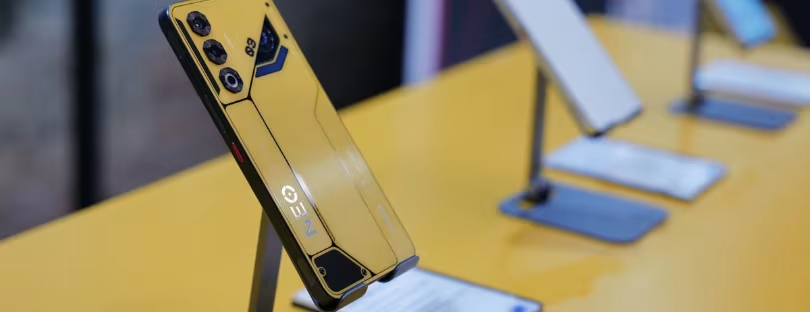
ZTE Doubles Down on Gaming Phones and AI Companions in Bold New Global Strategy
ZTE is betting big on two things for its next growth phase: youth-focused gaming smartphones and a full-scenario AI ecosystem designed to connect humans, homes, and devices.
The company unveiled this dual strategy during its ZTE Device Users Congress themed “Unlock Sensations, Define Style.”
A New ZTE for a New Generation
The tech giant isn’t just chasing specs—it’s chasing lifestyle relevance. Under its “2C transformation,” ZTE wants to become the tech brand that understands young consumers. That vision now revolves around the nubia Neo 3 series, a gaming smartphone line built for mobile e-sports, and a growing network of partnerships, including collaborations with Garena’s Free Fire and an AI virtual companion called Demi.
The nubia Neo 3 GT 5G Limited Edition, designed around the Free Fire character Kapella, is packed with serious hardware for serious gaming — 120 Hz display, AI Game Space 3.0, Dual Gaming shoulder triggers, and a multi-layer cooling system to keep performance smooth. It also brings in Demi, the AI gaming assistant that offers real-time tips and navigation. Launching first in Southeast Asia in October 2025, the phone starts at $249, signaling a clear play for the mid-range performance market.
Stylish Tech Meets Substance: nubia Air
ZTE is also reimagining what a durable, stylish phone can be. The nubia Air, set to debut globally in September for $279, combines rugged protection (IP69K/IP68), a massive battery, and AI functions — all in a thin, minimalist frame. ZTE calls this the beginning of the “Air-style” segment, aiming to balance aesthetic appeal and endurance in a category often split between fashion phones and utility devices.
AI with Emotion: Meet Mochi
Then there’s Mochi, ZTE’s most unexpected reveal — an AI-powered emotional companion designed to sense, listen, and respond to users. With soft textures and expressive eyes, Mochi isn’t just another smart gadget; it’s ZTE’s first step into the emotional AI market, a space growing rapidly thanks to products like Sony’s Aibo, Miko, and Rabbit R1.
“Mochi isn’t about performance,” said ZTE’s executives during the event. “It’s about connection.” Positioned under ZTE’s “AI for All” vision, it represents the company’s push to humanize technology and create emotional resonance in an era of digital fatigue.
Connectivity Remains the Backbone
Behind all the lifestyle branding, ZTE remains a powerhouse in connectivity. The company has held the #1 global market share in 5G fixed wireless and mobile broadband for four years. Its newest devices — the ZTE G5 Ultra, G5 Max Wi-Fi, and U60 Pro — push boundaries with AI-enabled 5G-A and Wi-Fi 7 technology. In plain terms, ZTE is laying the infrastructure for faster, smarter, and more intelligent device ecosystems.
Market Context: A Smart, Timely Pivot
ZTE’s pivot mirrors broader industry shifts. As Huawei invests heavily in HarmonyOS and AI integration, Xiaomi and realme chase the Gen-Z gaming and lifestyle segment, and Samsung experiments with Galaxy AI, ZTE is carving its lane by merging AI, emotion, and e-sports under one umbrella.
And it seems to be working — the company reports a 30% rise in smartphone revenue and 300% growth in the nubia Neo line in early 2025. Those figures place ZTE among the fastest-growing Chinese smartphone makers in global expansion, according to Counterpoint Research.
The Bigger Picture
What’s notable about ZTE’s new strategy isn’t just the hardware — it’s the emotional intelligence behind it. In a market where most brands are caught between AI buzzwords and incremental upgrades, ZTE is weaving connectivity, identity, and empathy into its product story.
The introduction of Mochi may seem whimsical, but it’s strategically aligned with where consumer tech is heading: devices that understand users, not just serve them. Combined with its stronghold in 5G infrastructure, ZTE is positioning itself as a bridge between tech performance and human experience — a move that could redefine how the brand is perceived globally.
Conclusion
ZTE’s evolution from a hardware-driven telecom brand to a lifestyle-oriented, AI-connected ecosystem reflects the same transformation that’s redefining the smartphone industry. Like Xiaomi’s ecosystem play, Samsung’s AI-first Galaxy strategy, or Honor’s youth-driven design push, ZTE’s mix of gaming focus, emotional AI, and 5G leadership taps into the next big consumer demand: technology that feels personal.
If executed well, this strategy could make ZTE not just another competitor in the mid-range smartphone race, but a trendsetter in AI-enhanced emotional tech — a space few have mastered but many are now eyeing.











